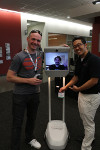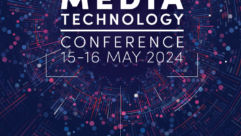
WHITE PLAINS, N.Y. — March 16, 2017 —
The
Society of Motion Picture and Television Engineers(R) (SMPTE(R))
, the organization whose standards work has supported a century of technological advances in entertainment technology, today announced program details for the Entertainment Technology in the Connected Age (ETCA) conference, May 8-9 at the Microsoft Silicon Valley Campus in Mountain View, California. Entitled “Redefining the Entertainment Experience,” this year’s conference will explore emerging technologies’ impact on current and future delivery of compelling connected entertainment experiences.
“Now in its fifth year, SMPTE is pleased to be hosting this year’s ETCA on the Microsoft campus in the heart of Silicon Valley, where engineers, executives, creatives, and researchers will gain a unique perspective on the technologies that are arguably redefining entertainment as we know it, while engaging with the leaders who are making it happen,” said Patrick Griffis, SMPTE executive vice president, and ETCA program chair. “This year’s program is extremely strong, and we look forward to a thought-provoking two days.”
Bob DeHaven, general manager of Worldwide Communications & Media at Microsoft Azure, will present the first conference keynote, titled “At the Edge: The Future of Entertainment Carriage.” The growth of on-demand programming and mobile applications, the proliferation of the cloud, and the advent of the internet-of-things demands that video content is available closer to the end user to improve both availability and the quality of experience. DeHaven will discuss the multifarious relationships taking shape to embrace these new requirements and will explore the roles network providers, content delivery networks (CDNs), network optimization technologies, and cloud platforms will play in achieving the industry’s evolving needs.
Hanno Basse, chief technical officer at Twentieth Century Fox Film Corporation, will present “Next-Generation Entertainment: A View From the Fox.” 20th Century Fox distributes content via outlets ranging from cinema to Blu-ray Disc, over-the-top (OTT), and even virtual reality (VR). Basse will share his views on the technical challenges of enabling next-generation entertainment in a connected age and how Fox plans to address them.
The first conference session, “Rethinking Content Creation and Monetization in a Connected Age,” will leap right into a discussion of multiplatform production and monetization using the latest creation, analytics, and search technologies. The session “Is There a JND in It for Me?” will take a second angle, exploring what new content creation, delivery, and display technology innovations will mean for the viewer. Panelists will discuss the parameters required to achieve original artistic intent while maintaining a just noticeable difference (JND) quality level for the consumer viewing experience.
“Video Compression: What’s Beyond HEVC?” likewise will explore emerging techniques and innovations, outlining evolving video coding techniques and their ability to handle new types of source material including high-dynamic-range (HDR) and wide color gamut (WCG) content, as well as video for virtual and augmented reality (VR/AR).
Moving from content creation and compression into delivery, “Linear Playout: From Cable to the Cloud” will discuss the current distribution landscape, looking at the consumer apps, smart TV apps, and content aggregators/curators that are enabling cord-cutters to watch linear television, as well as the new business models and opportunities shaping services and the consumer experience. The session will explore tools for digital ad insertion, audience measurement, and monetization while considering the future of cloud workflows.
“Would the Internet Crash If Everyone Watched the Super Bowl Online?” will shift the discussion to live streaming, examining the technologies that enable today’s services as well as how technologies such as transparent caching, multicast streaming, peer-assisted delivery, and User Datagram Protocol (UDP) streaming might enable live streaming at a traditional broadcast scale and beyond. “Adaptive Streaming Technology: Entertainment Plumbing for the Web” will focus specifically on innovative technologies and standards that will enable the industry to overcome inconsistencies of the bitrate quality of the internet.
“IP and Thee: What’s New in 2017?” will delve into the upgrade to internet protocol (IP) infrastructure and the impact of next-generation systems such as the ATSC 3.0 digital television broadcast system, the Digital Video Broadcast (DVB) suite of internationally accepted open standards for digital television, and fifth-generation mobile networks (5G wireless) on internet-delivered entertainment services. Moving into the cloud, “Weather Forecast: Clouds and Partly Scattered Fog in Your Future” examines how local networking topologies, dubbed “the fog,” are complementing the cloud by enabling content delivery and streaming via less traditional — and often wireless — communication channels such as 5G.
The rise of interactivity, as both a control mechanism and as a means of enhancing the viewing experience, will also be a theme of ETCA. “Giving Voice to Video Discovery” will highlight the ways in which voice is being added to pay television and OTT platforms to simplify searches. Panelists will discuss the benefits and challenges of implementing voice effectively, and the impact this trend will have on viewing behavior. In a session that explores new consumption models, “VR From Fiction to Fact” will examine current experimentation with VR technology, emerging use cases across mobile devices and high-end headsets, and strategies for addressing the technical demands of this immersive format.
Complete conference details, including registration information, are available at
. Early bird pricing is available through April 1.
Further information about SMPTE is available at
.
# # #
About the Society of Motion Picture and Television Engineers(R) (SMPTE(R))
For more than a century, the people of the Society of Motion Pictures and Television Engineers (SMPTE, pronounced “simp-tee”) have sorted out the details of many significant advances in media and entertainment technology, from the introduction of “talkies” and color television to HD and UHD (4K, 8K) TV. Since its founding in 1916, the Society has received an Oscar(R) and multiple Emmy(R) Awards for its work in advancing moving-imagery engineering across the industry. SMPTE has developed thousands of standards, recommended practices, and engineering guidelines, more than 800 of which are currently in force today. SMPTE Time Code” and the ubiquitous SMPTE Color Bars” are just two examples of the Society’s notable work. As it enters its second century, the Society is shaping the next generation of standards and providing education for the industry to ensure interoperability as the industry evolves further into IT- and IP-based workflows.
SMPTE’s global membership today includes more than 7,000 members: motion-imaging executives, creatives, technologists, researchers, and students who volunteer their time and expertise to the Society’s standards development and educational initiatives. A partnership with the Hollywood Professional Association (HPA) connects SMPTE and its membership with the businesses and individuals who support the creation and finishing of media content. Information on joining SMPTE is available at
.
All trademarks appearing herein are the properties of their respective owners.
Photo Link:
www.wallstcom.com/SMPTE/SMPTE_Richard-Welsh.jpg
Caption:
SMPTE Education Vice President Richard Welsh attends ETCA with a virtual attendee from PhaseSpace.
Photo Link:
www.wallstcom.com/SMPTE/SMPTE-Pat-Griffis.jpg
Caption:
Patrick Griffis, SMPTE Executive Vice President










